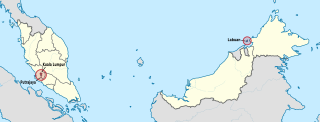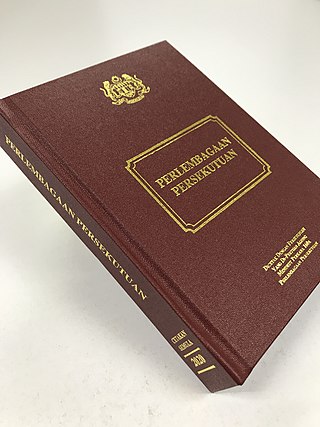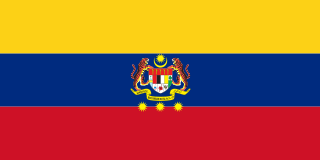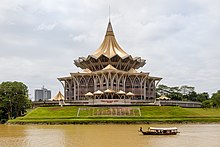
East Malaysia, or the Borneo States, also known as Malaysian Borneo, is the part of Malaysia on and near the island of Borneo, the world's third-largest island. East Malaysia comprises the states of Sabah, Sarawak, and the Federal Territory of Labuan. The small independent nation of Brunei comprises two enclaves in Sarawak. To the south and southeast is the Indonesian portion of Borneo, Kalimantan. East Malaysia lies to the east of Peninsular Malaysia, the part of the country on the Malay Peninsula. The two are separated by the South China Sea.

The Federal Territories in Malaysia comprise three territories—Kuala Lumpur, Labuan, and Putrajaya—governed directly by the Federal Government of Malaysia. Kuala Lumpur is the national capital of Malaysia, Putrajaya is the administrative capital, and Labuan is an offshore international financial centre. Kuala Lumpur and Putrajaya are enclaves in the state of Selangor, while Labuan is an island off the coast of Sabah.

The Federal Constitution of Malaysia, which came into force in 1957 as the Constitution of the Federation of Malaya and was amended in 1963 to form the Constitution of Malaysia, is the supreme law of Malaysia and contains a total of 183 articles. It is a written legal document influenced by two previous documents, the Federation of Malaya Agreement 1948 and the Independence Constitution of 1957. The Federation was initially called the Federation of Malaya and it adopted its present name, Malaysia, when the states of Sabah, Sarawak and Singapore became part of the Federation. The Constitution establishes the Federation as a constitutional monarchy, having the Yang di-Pertuan Agong as the Head of State with largely ceremonial roles. It provides for the establishment and organisation of three main branches of the government: the bicameral legislative branch called the Parliament, which consists of the House of Representatives and the Senate ; the executive branch led by the Prime Minister and his Cabinet Ministers and the judicial branch headed by the Federal Court.

Public holidays in Malaysia are regulated at both federal and state levels, mainly based on a list of federal holidays observed nationwide plus a few additional holidays observed by each individual state and federal territory. The public holidays are a mix of secular holidays celebrating the nation and its history, and selected traditional holidays of the various ethnic and religious groups that make up the country.

Malaysian registration plates are displayed at the front and rear of all private and commercial motorised vehicles in Malaysia, as required by law. The issuing of the number plates is regulated and administered by the Malaysian Road Transport Department or JPJ.

Singapore, officially the State of Singapore, was one of the 14 states of Malaysia from 1963 to 1965. Malaysia was formed on 16 September 1963 by the merger of the Federation of Malaya with the former British colonies of North Borneo, Sarawak and Singapore. This marked the end of the 144-year British rule in Singapore which began with the founding of modern Singapore by Sir Stamford Raffles in 1819. At the time of merger, it was the smallest state in the country by land area, but the largest by population.

The Government of Malaysia, officially the Federal Government of Malaysia, is based in the Federal Territory of Putrajaya, with the exception of the legislative branch, which is located in Kuala Lumpur. Malaysia is a federation comprising the 11 States of Malaya, the Borneo States of Sabah and Sarawak, and 3 Federal Territories operating within a constitutional monarchy under the Westminster system and is categorised as a representative democracy. The federal government of Malaysia adheres to and is created by the Federal Constitution of Malaysia, the supreme law of the land.
The high courts in Malaysia are the third-highest courts in the hierarchy of courts, after the Federal Court and the Court of Appeal. Article 121 of the Constitution of Malaysia provides that there shall be two high courts of co-ordinate jurisdiction—the High Court in Malaya and the High Court in Sabah and Sarawak. Before 1969, the High Court in Singapore was also part of the Malaysian courts system.
A state legislative assembly is the legislative branch of the state governments in each of the 13 Malaysian states. Members of a state legislative assembly comprises elected representatives from single-member constituencies during state elections through the first-past-the-post system.

Federal Territory Day is a territorial public holiday observed annually on 1 February by the federal territories of Kuala Lumpur, Labuan and Putrajaya in Malaysia. The date marks the anniversary of the transfer of Kuala Lumpur from the state of Selangor to the federal government, which occurred on 1 February 1974.

The following outline is provided as an overview of and topical guide to Malaysia:

Peninsular Malaysia, historically known as Malaya, also known as West Malaysia or the "Malaysian Peninsula", is the western part of Malaysia that comprises the southern part of the Malay Peninsula on Mainland Southeast Asia and the nearby islands. Its area totals approximately 132,490 km2 (51,150 sq mi), which is nearly 40% of the total area of the country; the other 60% is in East Malaysia on the island of Borneo.

The Malaysia Agreement, or the Agreement relating to Malaysia between United Kingdom of Great Britain and Northern Ireland, Federation of Malaya, North Borneo, Sarawak and Singapore (MA63) was the agreement which combined North Borneo (Sabah), Sarawak, and Singapore with the existing states of the Federation of Malaya, the resulting union being named Malaysia. Singapore was later expelled from Malaysia not long after this agreement, becoming an sovereign state on 9 August 1965.
The state governments in Malaysia are the governments ruling the 13 states in the federation of Malaysia. All 13 states adopts the Westminster Parliamentary system and each has a unicameral state legislative assembly. Each of the States of Malaya is run by an EXCO, while Sabah and Sarawak have their respective Cabinet and Ministry. The state government structure in all 13 states is similar to the government system of the federal government of Malaysia and that the state legislatures consist of only a single chamber.

The Proclamation of Malaysia was a statement, written in English and Malay, that declared the merger of the Federation of Malaya with the State of Singapore and the British crown colonies of North Borneo and Sarawak into the new Federation of Malaysia, following the enactment of the Malaysia Agreement and the Malaysia Act 1963 that July. The merger came into effect on 16 September 1963, and the proclamation was delivered on that date by Prime Minister Tunku Abdul Rahman in the Stadium Merdeka in Kuala Lumpur.

The 18-point agreement, or the 18-point memorandum, was a purported list of 18 points drawn up by Sarawak, proposing terms to form Malaysia, during negotiations prior to the creation of the new federation in 1963. Unlike the Sabah's 20-point memorandum whose authors are known and well documented, no such details have been produced for the so-called Sarawak 18-points memorandum.

On 4 April 2019, a bill proposing an amendment to the Constitution of Malaysia was tabled in the Dewan Rakyat of the Parliament of Malaysia. The bill proposes to amend Article 1(2) so as to restore the status of the two East Malaysian states of Sabah and Sarawak according to the original content of Malaysia Agreement that was signed in 1963.

The Constitution (Amendment) Act 2022 amended the Constitution of Malaysia to restore Sabah and Sarawak as equal partners to Malaya in Malaysia. This was intended to give effect to the Malaysia agreement of 1963. It was passed unanimously by the Dewan Rakyat on 14 December 2021 and came into effect after receiving royal assent on 11 February 2022.















































